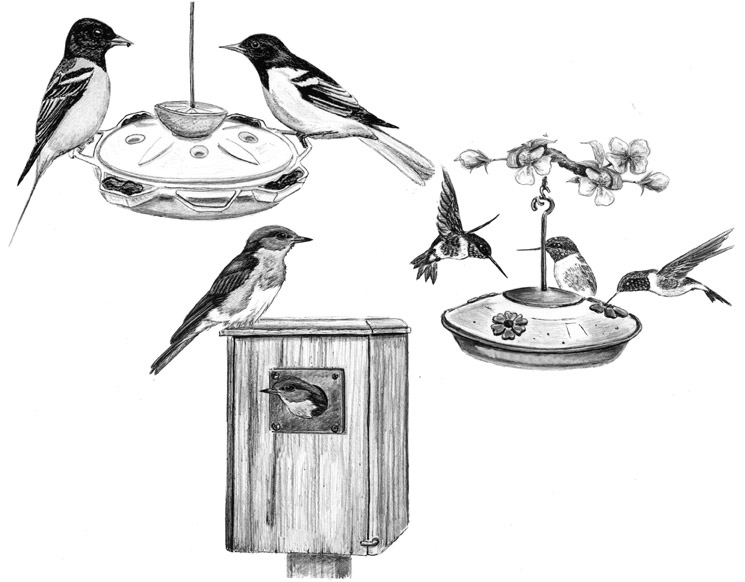
Dear Bird Folks,
Now that the nice weather has arrived and I can finally get out of the house, I’m wondering about my birdhouses. I never inspected them in the fall. Should I clean them out now?
– Sarah, Yarmouth Port, MA
No, Sarah,
Do not clean out your birdhouses now. That should have been done back in early March. It’s way too late now. Your birds could be using them. Cleaning nest boxes in May is like changing the sheets in your guest bedroom two days after your in-laws have arrived for their annual visit. At that point you’ll just have to let it go and hope they don’t notice any crumbs former guests have left in the bed.
I know it seems like spring has just arrived, but for many local birds it arrived back in March and April. Even in the middle of all that cold and windy weather, some early birds were “getting busy.” But you aren’t alone in thinking May is a good time for spring-cleaning. Last week a woman, also late cleaning her boxes, told me that she mistakenly pulled out a nest filled with fresh bluebird eggs. Oops! What did she do next, you ask? After looking around to make sure no one saw what she had done, the lady quickly placed both the nest and the eggs back in the box and everything was fine. Well, everything was fine until she noticed that one egg had smashed on the ground…and all the king’s horses and all the king’s men couldn’t put… Wait! The “king’s horses”? Why would anyone think that horses had the skills needed to reassemble broken eggs? Who came up with that plan?
Other than not cleaning out birdhouses, May is probably the most exciting time of year for backyard bird watchers. I know some people say we should take our feeders down when the warm weather arrives, but I don’t understand that. Right now migrating birds are streaming up from the south and some of those birds may (or may not) stop in our yards on their way to their breeding grounds. This week such glory birds as Rose-breasted Grosbeaks, Indigo Buntings, Blue Grosbeaks and Scarlet Tanagers have been reported at feeders all across the Cape. Folks who have taken their feeders down won’t get to see these beautiful birds…and it serves them right.
Not only are birds more abundant in May, they are also better looking. Their drab winter clothes have been replaced with showy spring outfits. Male goldfinches are the most obvious example of plumage changes. A few months ago goldfinches were dull greenish-brown birds and now they are brilliant yellow. Lots of people know that goldfinches are easily attracted to thistle (aka, niger or nyjer) feeders, but many don’t realize that it’s very important to offer finches fresh thistle. Thistle seed has a very short shelf life and the seed you bought last winter or (gag) last summer will likely be ignored by your birds this spring. If you find birds aren’t coming to your feeder, you need to clean it out and then go buy some new seed. (Don’t just refill your feeder with the same stale crap the birds haven’t been eating.) To keep things fresh it’s wiser to buy thistle in smaller quantities (five pounds-ish). And more importantly, buy it from a store that sells a lot of thistle and not from a place that sells seed as an afterthought, next to the wheelbarrows and the bags of lawn fertilizer. (You know where I’m talkin’ about.)
Speaking of stale food, I received a call from another lady (why is it always a lady?) who wanted to know if the hummingbird solution that she’s had in her refrigerator from last fall was still good. No, it’s not good. (Remind me never to borrow a cup of milk from this lady.) Hummingbird food is a simple sugar solution consisting of one part sugar to four parts tap water. (That’s right, four to one. Please try to remember that.) I generally take a cup of water, add a ¼ cup of sugar, stir until the sugar dissolves and that’s it. I don’t do any boiling and never add red food coloring or mint julep (except during the Kentucky Derby). After about three days I take the feeder down, wash it out and add fresh solution. Caution: If you wait too long between filling/cleaning, you not only won’t get any birds, your feeder will develop nasty black mold which is impossible to remove and the feeder could be ruined. (But no worries, I know where you can buy a new one.)
May is also the best month to attract those visually stunning Baltimore Orioles. Just about anyone who puts out orange halves or feeders offering grape jelly or sugar water in May will be visited by migrating orioles. Come June, however, the birds become focused on their nesting chores and can be less interested in oranges and jelly. So just be prepared for sudden abandonment. It’s okay. It happens to the best of us.
In addition to orioles, other feeder birds visit less often in June. Why? June is when all birds (except for the morally superior goldfinches, which are vegetarians) ignore birdseed and concentrate on feeding insects to their babies. Protein-packed insects help young birds grow more quickly. Because of this insect-fest, our feeders can be quite in June. Don’t worry, there is no need to call me about it or claim your birdseed is “no good” or that it’s “never happened before.” (Yes, it has.) This slowdown happens every June, so just relax. Once the baby birds fledge, your feeders will be active again. I know it’s sad to see your feeders quiet, but believe me, no one feels your pain more than I do. Quiet birdfeeders mean a quiet cash register. This is when I wish I were the one selling wheelbarrows and lawn fertilizer.